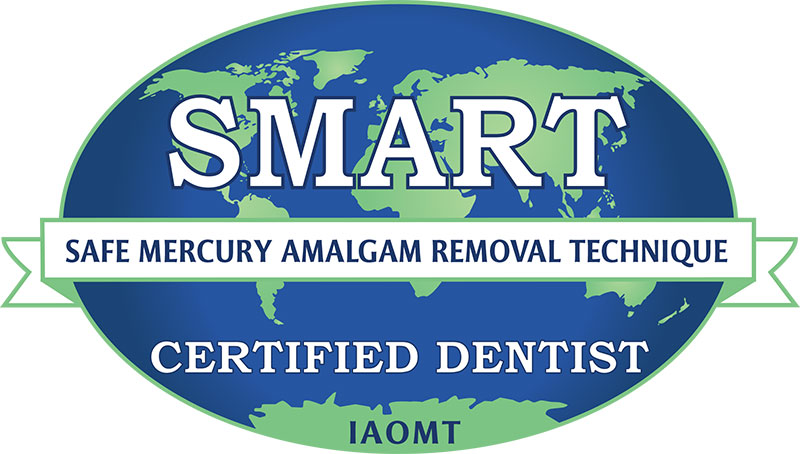What are dental amalgam fillings?
Dental amalgam is one of the first ancient and golden standard filling materials that has been used for over 150 years, and it is still used to fill dental cavities caused by tooth decay or tooth fracture. If your dentistry is not mercury-free, your dentist mixes will use a prepared capsule in which liquid (elemental) mercury is mixed (amalgamated) with powdered silver, copper, and tin compounds. The fillings will be inserted in your cavity in portions and condensed before setting and carving. Once the mercury amalgam mixture hardens, it forms a strong, solid, silver filling.
Mercury is a chemical naturally occurring in rocks, including the earth’s crust. It exists in three chemical forms:

Elemental Mercury
This is the metallic liquid form of mercury, which is often used in barometers, fluorescent lights, and some light switches.
Inorganic Mercury
These compounds enter the environment through coal burning or manufacturing processes. People working in mines or manufacturing electrical equipment are exposed to higher levels of inorganic compounds. Sadly, some skin-lightening facial creams or lipsticks may also contain these mercury compounds.
Methylmercury
These organic compounds are found to a high content in seafood, fish, and shellfish.
Elemental mercury
Elemental mercury used in dental amalgams is a liquid metal that appears silvery-white at room temperature.
While being safe in a contained form such as a thermometer or barometer, mercury evaporates into a toxic, odourless vapour you could inhale when exposed to room temperature air.
As dental amalgam fillings contain elemental mercury up to 50% by weight, hundreds of clinical studies have associated a few adverse health effects with dental amalgam, including thyroid dysfunction.
Both laboratory and clinical studies have demonstrated increased mercury leakage digestion and vapour inhalation from the amalgam fillings during brushing, chewing, or teeth grinding.
Surprisingly, the Environmental Protection Agency (EPA) consider these estimated quantities of amalgam exposure to be within the safe!
Short or long-term exposure to elemental mercury can be biologically very harmful and cause symptoms such as memory decline and cognitive problems, emotional changes, headaches, neurological disorders, tremors and sleeping disorders.
On the other hand, specific individuals could be at greater risk of the biological adverse effects of mercury exposure, including pregnant women, nursing women and their infants, children under the age of six, individuals with a sensitivity to mercury or other components of dental amalgam, people with kidney impairment and patients with neurological disorders.
Is there a home test for mercury poisoning?
Home mercury poisoning tests are available with instructions, or you can have a home nurse take a blood sample. Typically, mercury is found in the body at harmless levels from daily exposure to sources like seafood, certain cosmetics, and dental amalgam, which emit mercury vapour. High exposure to elemental mercury vapour from items like thermometers and lightbulbs can cause neurotoxic effects, especially in the brain and central nervous system. The World Health Organisation notes that behavioural changes can follow inhalation of various mercury compounds.
Health impacts from mercury depend on the amount and type ingested and individual factors like age and pregnancy. Teeth grinding can elevate mercury risks from fillings due to increased pressure. Methylmercury exposure is particularly hazardous for children and foetuses with developing nervous systems.
Symptoms that may prompt mercury testing include memory issues, metallic taste, abdominal pain, sleeplessness, numbness, involuntary eye tremors, dizziness, hearing loss, unclear speech, depression, coordination problems, fatigue, and restless legs.
What are the health hazards of Amalgam Fillings for pregnant women and children?
Mercury exposure from dental amalgam fillings is a significant health concern, especially for pregnant women and children. A World Health Organisation report from 2005 detailed the potential for serious health problems due to mercury, such as developmental issues and neurological damage. International warnings and actions from U.S. Congress members, including a proposed but not enacted Mercury Filling Disclosure and Prohibition Act, highlight the risks to vulnerable populations.
Research indicates that the number of amalgam fillings in pregnant women correlates with higher mercury levels in various foetal and infant tissues and breast milk. This exposure has been associated with an increased risk of perinatal death, as found in a Norwegian study of over 72,000 pregnant women. While some studies have defended amalgam use, others have pointed out the necessity of considering long-term effects, genetic factors, and potential measurement errors.
Criticism of amalgam use is underpinned by the fact that children, due to their smaller size and developmental stage, may require different safety thresholds for mercury exposure.
Considering these findings, a recent study strongly recommends revising dental practices involving amalgam to prevent unnecessary mercury exposure, particularly in children, reaffirming the ongoing concerns within the scientific community.

How do we assess and Manage the Biological Risks of Mercury Exposure?
Mercury is a toxic metal in various environmental forms. Mercury poisoning, caused by high mercury intake, can arise from sources like dental amalgam fillings and seafood containing methylmercury. Healthcare providers commonly use urine, blood, and faecal tests to diagnose mercury poisoning.
Urine mercury tests detect inorganic mercury, with levels under 10 mcg/L considered normal. High urine mercury levels might indicate a need for detoxification. Faecal tests measure exposure to dietary toxic metals and can reflect the number of dental amalgam fillings. Blood tests reveal recent mercury exposure but are less reliable over time as mercury levels in blood decrease quickly.
Symptoms of acute mercury poisoning include nausea, diarrhoea, and an increased heart rate. Treatment is necessary when tests indicate mercury toxicity. This article aims to inform about the testing methods for mercury poisoning from dental fillings, highlighting urine and blood tests as the most effective.
Mercury is a toxic metal in various environmental forms. Mercury poisoning, caused by high mercury intake, can arise from sources like dental amalgam fillings and seafood containing methylmercury. Healthcare providers commonly use urine, blood, and faecal tests to diagnose mercury poisoning.
Urine mercury tests detect inorganic mercury, with levels under 10 mcg/L considered normal. High urine mercury levels might indicate a need for detoxification. Faecal tests measure exposure to dietary toxic metals and can reflect the number of dental amalgam fillings. Blood tests reveal recent mercury exposure but are less reliable over time as mercury levels in blood decrease quickly.
Symptoms of acute mercury poisoning include nausea, diarrhoea, and an increased heart rate. Treatment is necessary when tests indicate mercury toxicity. This article aims to inform about the testing methods for mercury poisoning from dental fillings, highlighting urine and blood tests as the most effective.
How to minimise and counteract mercury toxicity
Please take these steps: Limit intake of high-mercury fish such as bluefin tuna and swordfish, and opt for lower-mercury seafood like haddock, salmon, sardines, and scallops, using resources like Seafood Selector for guidance. The FDA advises pregnant women to avoid certain high-mercury fish. Support your liver’s detox function by consuming foods rich in alkaline, B12, folate, and liver-friendly nutrients, with cilantro notably beneficial against heavy metals. Some supplements, such as selenium, can mitigate mercury’s adverse health effects. If you’re considering mercury filling removal, you’d need a dentist skilled in the SMART technique to discuss safe amalgam removal and suitable replacement materials. At Rejuvenation Dentistry, our biological dentists understand the systemic influence of oral health and can guide you through amalgam filling replacement to enhance your overall well-being.
Is there any association between Dental Amalgam Fillings and hypothyroidism?
Heavy metal exposure has been suggested to be the potential trigger and exacerbate autoimmune conditions in genetically predisposed individuals. Studies show that amalgam mercury can accumulate in thyroid cells and cause thyroid disorders by:
-
Changing the genetic makeup
Hence causation of certain types of cancer, including thyroid cancer.
It also could lead to a Thyroid autoimmune disorder called Hashimoto’s thyroiditis. The autoimmune reactions caused by a high level of mercury would promote triggering our immune system, which in turn would destroy our own healthy cells, including our thyroid cells, the condition called Hashimoto’s thyroiditis. -
Raising the oxygen free radical levels
The research shows that when the balance between the beneficial antioxidants and harmful free radicals is changed, the emergence of Oxidative stress, and in turn, the resulting chronic inflammation may contribute to an increased risk of thyroid under-activity, including Hashimoto’s thyroiditis.
-
Binding of dietary mercury to Selenium
Hence reduced selenium. This would lead to selenium deficiency.
As a result, we may experience symptoms caused by hypothyroidism, including the following: Cold intolerance, constipation, dry skin, fatigue, joint pain, mental health changes or mood swings, muscle weakness and insomnia.
Mercury Filling Removal Resources
If you are planning to remove your amalgam mercury fillings, we can help you avoid ongoing exposure to mercury. Our SMART-certified dentists are familiar with the safest amalgam removal procedures, and they can advise you to determine how to replace your foiling with bio-compatible fillings and ceramic restorative materials. Our certified biological dentists can help you restore your health.
Please book your consultation for your amalgam filling replacement. We at London Specialist Dentist see beyond your smile and recognise the impact of your oral health on your body.
Meet our certified holistic and biological dentists
For the removal of the existing amalgam fillings, we follow the strict SMART protocol set by the International Academy of Oral Medicine and Toxicology. Our dentists are SMART certified by the International Academy of Oral Medicine and Toxicology (IAOMT).
We believe in a partnership with our patients. By working together, we aim to cultivate a lifestyle and diet that nurtures not just your oral health, but also your overall immunity. Our approach is comprehensive, we consider both your physical and emotional well-being in our oral health treatments, ensuring that the care you receive is deeply personalised.
Understanding the relationship between oral health issues like tooth decay, gum disease, and wider chronic health problems is crucial to us. We’re also attentive to how certain oral chemicals can affect your immune system and disrupt the delicate balance of your microbiome. Our commitment lies in exploring and implementing more advanced and effective healing techniques to address these complex health interactions.
Dr. Nico Kamosi

Dr. Nora Cumiskey

Dr Nora is a fully qualified dentist with a special interest in holistic and biological Dentistry. She focuses on dental treatments that consider whole body health, rather than focusing on just the health of the mouth. It will involve a more comprehensive look at how your oral health can impact the rest of your body, and how your lifestyle could be impacting the health of your mouth.
Dr Nora is very passionate about and conscious of your overall health; in that aspect she provides a different perspective on your care to what you can expect to find in general dental clinics. We do not use amalgam (silver) filling material, that is approximately 50% mercury, a highly polluting neurotoxin.
FAQs: Common Questions Patients Ask About Amalgam Filling Removal
Many of our patients inquire about the benefits of removing amalgam fillings. Our holistic approach considers not only the aesthetics but also the impact on overall health. Removing amalgam fillings, which contain mercury, can reduce potential exposure to this heavy metal. We replace them with biocompatible materials that are safer and more in harmony with your body’s natural chemistry. Additionally, patients often find that newer materials offer a more natural look, aligning better with their dental aesthetics.
Yes, patient safety is our top priority, especially when it comes to procedures like removing amalgam fillings. We use advanced techniques to minimise exposure to mercury during the removal process. Our clinic is equipped with latest specialised equipments, and we employ protective measures for both the patient and staff to ensure a safe, controlled environment. Post-removal, we focus on supporting your oral and overall health to aid in recovery and maintain the balance of your oral microbiome.
A common question we receive is about the alternatives available once amalgam fillings are removed. Our clinic specialises in providing modern, health-conscious solutions. We offer composite fillings, which are not only durable but also closely match the natural colour of your teeth, providing a seamless appearance. These fillings are free from metals like mercury, making them a safe and aesthetically pleasing choice. In addition to their visual appeal, composite bond directly to the tooth, offering reinforced structural support and minimising the risk of future decay or damage
